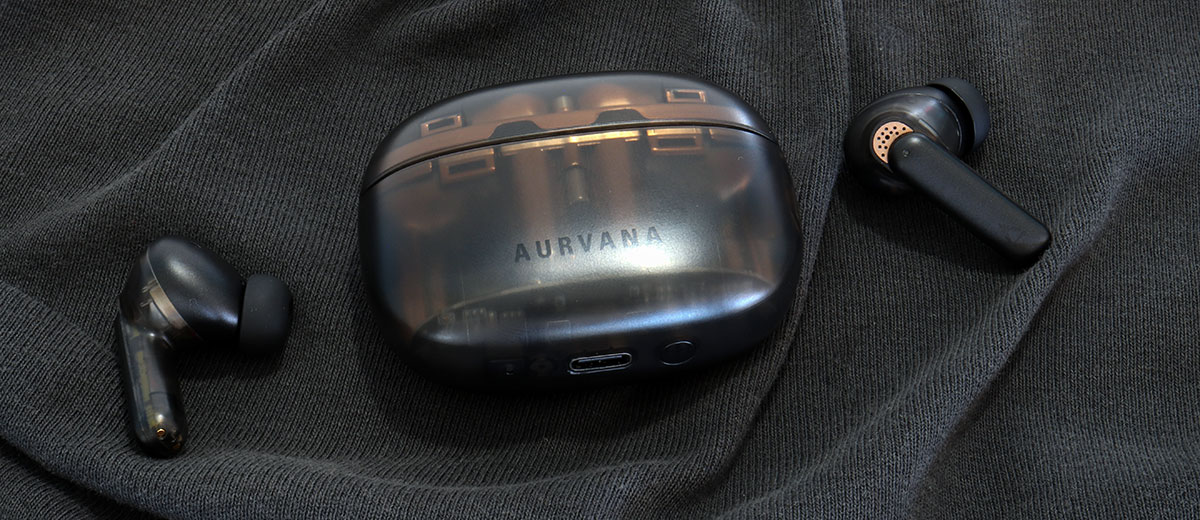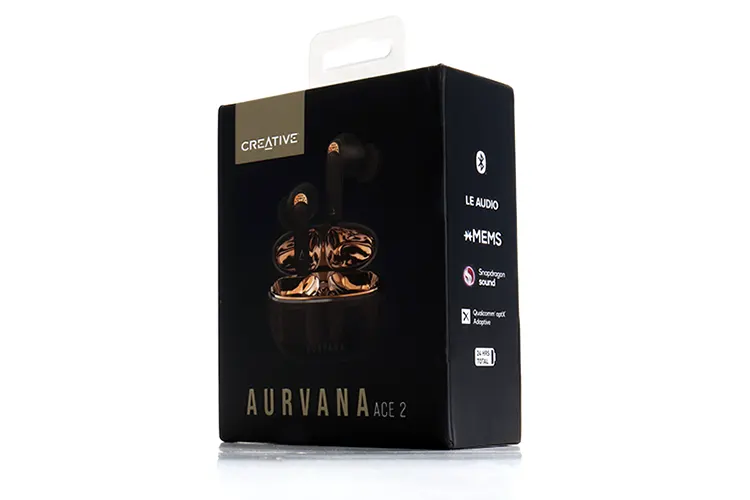Sound Impressions
Listening tests were done using a 5.2 Bluetooth radio-equipped mobile device and known FLAC files. I used an Android-equipped device with JetAudio + and the SFXI player on occasion.
All settings were placed on flat sonically, and the ANC was placed on the disabled setting. I also kept the low-latency feature off during listening tests.
Bass
The Aurvana Ace 2 bass response is full-bodied, bloomy, and has lots of energy behind it. The bass response is produced with quite a hard-hitting impact.
This characteristic is mostly around 50Hz and up to the 100Hz frequency range. Above 100Hz it still has lots of slam and sits a couple of decibels above the lower midrange.
The bass response is rather clean even though it seems elevated most times. They portray an Urban tune that caters to EDM, Hip-Hop, and all sorts of popular music that needs good bass representation.
But although there’s an elevation, there’s still a good amount of note distinction and enough delicacy to produce clean enough bass with other genres.
Midrange
The midrange is relaxed and smooth with a touch of airiness, although the vocal presentation seems centered and most times placed as a phantom center channel.
The midrange sits right below the bass response in quality and volume, giving this set a slight V-shaped sound signature. It’s not overcooked in any way because the differences are only a few decibels from each other and balanced enough for a clear distinction of elements.
Vocal tonality seems warm and deep in tone, especially female vocals which are produced with a slightly thick characteristic But so are male vocals. Instruments take center stage on most occasions as mentioned and are fairly close to true tone.
Treble
The treble response is the best part of the overall signature. I don’t have the first Aurvana Ace here to compare directly, but I have heard them, and if I remember well, the high frequencies were not this good.
The first thing you’ll notice is their crystallinity and that’s attributed to the sheer speed of these drivers. These drivers have a quick response time and their transient response is off the charts.
The high frequencies are produced with a high level of precision and I would consider the Creative Aurvana Ace 2 high-frequency production to be one of the best at this price tier and only surpassed by a handful of high-dollar expensive TWS models.
Staging and Dynamics
The staging capabilities of the Creative Aurvana Ace 2 can be described as wide but not too tall or deep. The overall presentation seems to create a phantom center channel that focuses most of the midrange centerstage.
The bass and midrange do produce some interesting sound staging properties but the xMEMS tweeters are the star of the show and most imaging precision occurs within the high frequencies.
Wireless Performance
Stability and Range
Creative is being modest with the transmission distance capabilities of the Aurvana Ace 2’s reception range. They specify that you will get a maximum distance of up to 33 feet.
I’m happy to inform you that I could walk away in a straight line at least 45 feet away with no dropouts and no change in latency either. I could more than likely go further but that is the longest strip inside my home that I could test in a visible straight line.
Mind you, I was using a mobile device with a Bluetooth 5.2 radio and you should technically obtain better results if you used a 5.3 radio.
This set does seem to have what’s called true wireless in that one earbud can be used at a time successfully and they do switch automatically. All you have to do is remove one and slip one back into the cradle. The switchover seems to be performed quickly in this set.
Latency
The Creative Aurvana Ace 2 is an excellent choice if you need a low-latency TWS set. I was quite content with this set’s latency in stock form plus their natural noise-blocking ability makes this set a good TWS for watching movies and videos.
That’s before you engage the low latency because then the latency becomes nill. Again, that feature can be activated within the Creative app and it resides inside the settings menu. To be honest, I never enabled the feature because there was never a need for it.
Select Comparisons
TOZO Golden X1
Technical
The TOZO Golden X1 came out of nowhere and became a set that many turned to for a good TWS that offered all the general features you need plus a sound signature that was quite pleasing.
This set took a different approach, and to be honest, I feel it was the correct one. This set works with LDAC with similar Bluetooth 5.3 tech. When it comes to gear that’s equipped to handle LDAC is 500 to 1 versus aptX Lossless compatible gear.
The TOZO Golden X1 counts on a similar two-driver setup, but the X1 uses a common BA driver alongside a 12mm dynamic driver. This two-way driver configuration is tuned with what TOZO calls ORIG X Pro which is a DSP implementation that improves the set’s sonic overall tonality.
TOZO also supplies the buyer with an app called TOZO Technology Surrounds You which is my favorite within this comparison.
Design
One drawback that the TOZO Golden X1 has is the size of the cradle which is double in size compared to the Aurvana Ace 2.
You do get the extra feature on the TOZO Golden X1 cradle which is the additional LED display that shows the battery charge amount in percentage.
The earbuds have an improved ability to anchor inside the ear without compromising comfort. TOZO went with a bean and stem design as well but the stem is short and harder to grab. However, the tip’s stem is pushed inward allowing this set to be the best choice for physical activity.
Performance
Your choice should depend on whether your gear is aptX Lossless ready or not. If it is, then you’re golden, no pun intended. You will get superior performance from the Ace 2 if you can use the aptX Lossless codec.
If not, then you’re best off with the TOZO Golden X1. I hate to repeat myself but some of these new sets that have the aptX Lossless capability, for some reason, omit LDAC compatibility and that’s a big con.
Sonically, the TOZO Golden X1 has a better midrange section because it has an increase in presence in that area. The overall sonic presentation is not as bloated in the bass frequencies is another characteristic you will hear.
I do feel that the Aurvana Ace 2 has the best highs, but the TOZO Golden X1 has the second-best highs within this comparison. Bass response? That’s a win for the Ace 2 as well even though it’s sonically elevated.
1MORE EVO
Technical
The 1MORE EVO counts on a similar driver configuration as the TOZO Golden X1. In this case, it consists of a DLC 10mm dynamic driver alongside an unspecified balanced armature driver that is commissioned to produce the high frequencies.
The EVO relies on a Bluetooth 5.2 radio and is another LDAC-capable set. Here’s another TWS that after attempting to obtain what type of SOC was used, was unsuccessful.
The EVO also includes an app but it was basic when I first used it but they’ve revamped their app recently and have included more features and have given the app a fresh look.
Design
Hands down, the 1MORE EVO is the best-looking set within this comparison. The backplates look as if they have Black Onyx jewel inlay. A copper ring decorates the backplate even further.
The EVO does have an additional feature, a photosensor that shuts the earbud off or pauses the media player the second you take them off.
However, the cradle seems to be the heaviest and the second largest within this comparison. Then again, the EVO’s cradle seems to be the most robust within this comparison. To confine, the 1MORE EVO seems to have the best build quality within this comparison.
Performance
The 1MORE EVO is a smooth-sounding TWS but also has a slightly V-shaped sound signature that emphasizes bass response and prioritizes those low-frequency bands to raise the fun factor.
But in general, you run into the same dilemma as the other compared TWS model in that sound quality will depend on what your device is capable of, either LDAC or aptX Lossless. And as we speak LDAC is more attractive because of the high level of availability.
The EVO and Ace 2 provide the listener with a similar slight V-shaped sound signature but the Aurvana Ace 2 has unbeatable highs in this price segment.
My Verdict
The Creative Aurvana Ace 2 is a standout True Wireless System mostly because of the xMEMS driver upgrade and it’s an improvement that is not just seen on paper but one that’s audible. Including the xMEMS tweeter is certainly a step forward in the TWS genre.
But once again, manufacturers should not bet on a single horse because it’s counterintuitive to me. The aptX lossless codec is just starting to gain ground but needs more time to gain presence in the marketplace and hopefully, it’s here to stay which will future-proof this set.
Aside from that, the Creative Aurvana Ace 2 is a very stable TWS free from bugs. They perform beyond the expectations of common functionality with a clean-sounding microphone system, and they sound good too. Recommended.
Creative Aurvana Ace 2 TWS specifications
- Noise cancellation: Adaptive hybrid active noise cancellation with Ambient Mode
- Total battery life: up to 24 hours
- Playtime per charge: up to 6 hours
- Total weight: 46.6g (1.64 oz)
- Dimensions: 64.7 x 49.1 x 26.9 mm (2.55 x 1.93 x 1.06 inches)
- Driver: xMEMS solid state driver, 10mm dynamic driver
- Audio codec: LC3, aptX Lossless, aptX Adaptive, aptX, AAC, SBC
- Microphone setup: 3 microphones per earbud
- Controls: Customizable touch control via Creative App
- Software Super X-FI: Super X-FI ready
- SIRI, Google Assistant; Yes
- Water resistance: IPX5
- Connectivity: Bluetooth 5.3
- Interface: Wireless charging enabled and QI charging compatible, USB-C
- App: Creative App
- Color: Black and Copper





